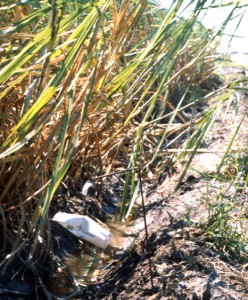 Chemical attractants. Insects and other arthropods are attracted to animal and plant hosts through chemicals either on contact or in the air (see section, “Food-baited jars” and “Baiting for moths and beetles”). Their keen ability to detect odors also allows them to detect other insects of the same or even unrelated species. The understanding of these chemical communication systems has allowed collectors to find unique ways of obtaining specimens for study.
Chemical attractants. Insects and other arthropods are attracted to animal and plant hosts through chemicals either on contact or in the air (see section, “Food-baited jars” and “Baiting for moths and beetles”). Their keen ability to detect odors also allows them to detect other insects of the same or even unrelated species. The understanding of these chemical communication systems has allowed collectors to find unique ways of obtaining specimens for study.
Carbon Dioxide (CO2, dry ice):
As an attractant – Arthropods seeking warm-blooded animals that emit CO2 through respiration are attracted to this gas. Dry ice is a solid form of this gas that can be often purchased locally from companies that sell bottled gas and welding supplies. When placing it on the ground on a surface like a board, gas emitted will attract ticks. When hung in a mesh bag in a Malaise trap, CO2 is attractive to biting flies like horse and deer flies (Tabanidae).
 As an anesthetizing agent – CO2 in pressurized cylinders can be used to immobilize insects (i.e., put them to sleep). The gas can be used when sorting live specimens from field-collected trash and is ideal for use in close-up photography in indoor settings (as is refrigerating or freezing these cold-blooded animals to slow them down). Exposing insects to CO2 too long will, however, kill them.
As an anesthetizing agent – CO2 in pressurized cylinders can be used to immobilize insects (i.e., put them to sleep). The gas can be used when sorting live specimens from field-collected trash and is ideal for use in close-up photography in indoor settings (as is refrigerating or freezing these cold-blooded animals to slow them down). Exposing insects to CO2 too long will, however, kill them.
As a killing agent – Also, placing a block of dry ice in a Styrofoam cooler makes an idea field freezer that can kill insect specimens almost instantaneously.
Pheromones. Chemicals that arthropods produce that have a behavioral effect on other arthropods are called pheromones. A number of these are now commercially available to be used in traps to attract insects. Many of these are sex attractants which are produced by one sex (in moths, usually the female) to attract the other sex. Some are food attractant scents such as floral scents.
Traps often incorporate a stick material to trap insects for population monitoring purposes, but scents can also be used in live traps to collect quality specimens.
You can use pheromone attraction without having to purchase synthetically-manufactured products, too. If you are lucky enough to raise a silk moth in captivity, keep the females in a screen cage to attract additional male specimens.
Sources of pheromones and traps (these sources and others also listed on http://insects.tamu.edu):
Fermone® Corporation, Inc.
2620 North 37th Drive
Phoenix, AZ 85009
602/233-9047; FAX: 602/254-7989
Pest Management Supply, Inc.
Scentry™ Monitoring Products
P.O. Box 426
Buckeye, AZ 85326-0900
602/386-6737; FAX: 602/386-4887
Trece Incorporated
P.O. Box 6278
1143 Madison Lane
Salinas, CA 93912
408/758-0205; FAX: 408/758-2625
Octenol. Collection of horse and deer flies (Tabanidae) has been improved using the chemical attractant 1 Octen-3-ol (French, F. E. and D. L. Klein. 1989. 1-Octen-3-ol, an effective attractant for Tabanidae (Diptera). J. Med. Ent. 26:459-61).
Baiting for moths and beetles. Many moths, beetles and some butterflies (such as hackberry butterflies and tawny emperors) are attracted to sweet, fermenting liquids (see section on “Food-baited jars). Recipes vary among collectors, providing for heated discussions about which one works best! Mixtures of bananas, brown sugar and beer can be painted onto tree trunks or placed in milk jugs hung in trees with holes cut into the sides. Beetles attracted to the bait generally become trapped in the oozing bait materials where they can be retrieved and cleaned up by rinsing in water before further processing.
